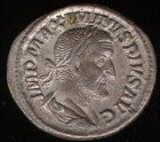
Roman currency
Overview
The Roman currency during most of the Roman Republic
and the western half of the Roman Empire
consisted of coins including the aureus
(gold), the denarius
(silver), the sestertius
(brass), the dupondius
(brass), and the as
(copper). These were used from the middle of the third century BC until the middle of the third century AD.
They were still accepted as payment in Greek influenced territories, even though these regions issued their own base coinage and some silver in other denomination
s, either called Greek Imperial or Roman provincial coins
.
During the third century, the denarius was replaced by the double denarius, now usually known as the antoninianus
or radiate, which was then itself replaced during the monetary reform of Diocletian
which created denominations such as the argenteus
(silver) and the follis
(silvered bronze).
Roman Republic
The Roman Republic was the period of the ancient Roman civilization where the government operated as a republic. It began with the overthrow of the Roman monarchy, traditionally dated around 508 BC, and its replacement by a government headed by two consuls, elected annually by the citizens and...
and the western half of the Roman Empire
Roman Empire
The Roman Empire was the post-Republican period of the ancient Roman civilization, characterised by an autocratic form of government and large territorial holdings in Europe and around the Mediterranean....
consisted of coins including the aureus
Aureus
The aureus was a gold coin of ancient Rome valued at 25 silver denarii. The aureus was regularly issued from the 1st century BC to the beginning of the 4th century, when it was replaced by the solidus...
(gold), the denarius
Denarius
In the Roman currency system, the denarius was a small silver coin first minted in 211 BC. It was the most common coin produced for circulation but was slowly debased until its replacement by the antoninianus...
(silver), the sestertius
Sestertius
The sestertius, or sesterce, was an ancient Roman coin. During the Roman Republic it was a small, silver coin issued only on rare occasions...
(brass), the dupondius
Dupondius
The dupondius was a brass coin used during the Roman Empire and Roman Republic valued at 2 asses ....
(brass), and the as
As (coin)
The , also assarius was a bronze, and later copper, coin used during the Roman Republic and Roman Empire.- Republican era coinage :...
(copper). These were used from the middle of the third century BC until the middle of the third century AD.
They were still accepted as payment in Greek influenced territories, even though these regions issued their own base coinage and some silver in other denomination
Denomination (currency)
Denomination is a proper description of a currency amount, usually for coins or banknotes. Denominations may also be used with other means of payment like gift cards. See also Redenomination.-Subunit and super unit:...
s, either called Greek Imperial or Roman provincial coins
Roman provincial coins
Roman Provincial coins are coins that were minted in the Roman Empire by civic authorities rather than by Imperial authorities. Often these coins were a continuation of the original currency system that existed prior to the arrival or conquest by the Romans....
.
During the third century, the denarius was replaced by the double denarius, now usually known as the antoninianus
Antoninianus
The antoninianus was a coin used during the Roman Empire thought to have been valued at 2 denarii. It was initially silver, but was slowly debased to bronze. The coin was introduced by Caracalla in early 215 and was a silver coin similar to the denarius except that it was slightly larger and...
or radiate, which was then itself replaced during the monetary reform of Diocletian
Diocletian
Diocletian |latinized]] upon his accession to Diocletian . c. 22 December 244 – 3 December 311), was a Roman Emperor from 284 to 305....
which created denominations such as the argenteus
Argenteus
The argenteus was a silver coin produced by the Roman Empire from the time of Diocletian's coinage reform in AD 294 to ca. AD 310. It was of similar weight and fineness as the denarius of the time of Nero...
(silver) and the follis
Follis
The follis was a type of coin in the Roman and Byzantine traditions.-Roman coin:The Roman follis was a large bronze coin introduced in about 294...
(silvered bronze).
Unanswered Questions

